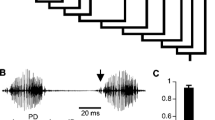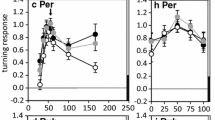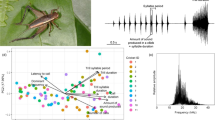Summary
Temperature effects on calling song production and recognition were investigated in the North American field cricket, Gryllus firmus. Temporal parameters of field-recorded G. firmus calling song are strongly affected by temperature. Chirp rate and syllable rate increase, by factors of 4 and 2, respectively, as linear functions of temperature over the range in which these animals sing in the field (12°–30 °C). Temperature affects syllable duration to a lesser extent, and does not influence calling song carrier frequency. Female phonotactic preference, measured on a spherical treadmill in the laboratory, also changes with temperature such that warmer females prefer songs with faster chirp and syllable rates. Best phonotaxis, measured as accuracy of orientation to the sound source, and highest walking velocity, occur in response to temperature-matched songs at 15°, 21°, and 30 °C. Experiments under semi-natural conditions in an outdoor arena revealed that females perform phonotaxis at temperatures as low as 13 °C. Taken together, the song and phonotaxis data demonstrate that this communication system is temperature coupled. A strategy is outlined by which temperature coupling may be exploited to test hypotheses about the organization of neural networks subserving song recognition.
Similar content being viewed by others
Abbreviations
- CP :
-
chirp period
- SP :
-
syllable period
- SD :
-
syllable duration
References
Alexander RD (1957) The taxonomy of the field crickets of the eastern United States (Orthoptera: Gryllidae: Acheta). Ann Entomol Soc Am 50: 584–602
Alexander RD (1968) Life cycle origins, speciation, and related phenomena in crickets. Q Rev Biol 43:1–41
Alexander RD, Meral GH (1967) Seasonal and daily chirping cycles in the northern spring and fall field crickets, Gryllus veletis and G. pennsylvanicus. Ohio J Sci 67:200–209
Batschelet E (1981) Circular statistics in biology. Academic Press, New York
Bauer M, Heiversen O von (1987) Separate localization of sound recognizing and sound producing neural mechanisms in a grasshopper. J Comp Physiol A 161:95–101
Cade WH (1976) Male reproductive competition and sexual selection in the field cricket Gryllus integer. Ph.D. Thesis, University of Texas, Austin
Cade WH (1979) The evolution of alternative male reproductive strategies in field crickets. In: Blum MS, Blum NA (eds) Sexual selection and reproductive competition in insects. Academic Press, New York, pp 343–378
Campbell DJ, Shipp E (1979) Regulation of spatial pattern in populations of the field cricket Teleogryllus commodus (Walker). Z Tierpsychol 51:260–268
Carlson AD, Copeland J, Raderman R, Bulloch AGM (1976) Role of interflash intervals in a firefly courtship (Photinus macdermotti). Anim Behav 24:786–792
Doherty JA (1985a) Temperature coupling and “trade-off” phenomena in the acoustic communication system of the cricket, Gryllus bimaculatus De Geer (Gryllidae). J Exp Biol 114:17–35
Doherty JA (1985b) Trade-off phenomena in calling song recognition and phonotaxis in the cricket, Gryllus bimaculatus (Orthoptera, Gryllidae). J Comp Physiol A 156:787–801
Doherty JA (1985c) Phonotaxis in the cricket Gryllus bimaculatus De Geer: comparisons of choice and no-choice paradigms. J Comp Physiol A 157:279–289
Doherty JA, Gerhardt HC (1984) Acoustic communication in hybrid treefrogs: sound production by males and selective phonotaxis by females. J Comp Physiol A 154:319–330
Doherty JA, Hoy R (1985) Communication in insects. III. The auditory behavior of crickets: some views of genetic coupling, song recognition, and predator detection. Q Rev Biol 60:457–472
Doherty JA, Pires A (1987) A new microcomputer-based method for measuring walking phonotaxis in field crickets (Gryllidae). J Exp Biol 130:425–432
Doolan JM, Pollack GS (1985) Phonotactic specificity of the cricket Teleogryllus oceanicus: intensity-dependent selectivity for temporal parameters of the stimulus. J Comp Physiol A 157:223–233
Elliot CJH, Koch UT (1985) The clockwork cricket. Naturwissenschaften 72:150–153
Eisner N, Popov AV (1978) Neuroethology of acoustic communication. Adv Insect Physiol 13:229–335
French BW, Cade WH (1987) The timing of calling, movement, and mating in the field crickets Gryllus veletis, G. pennsylvanicus, and G. integer. Behav Ecol Sociobiol 21:157–162
Gerhardt HC (1978) Temperature coupling in the vocal communication system of the gray treefrog, Hyla versicolor. Science 199:992–994
Gerhardt HC, Doherty JA (1988) Acoustic communication in the gray treefrog Hyla versicolor: evolutionary and neurobiological implications. J Comp Physiol A 162:261–278
Gould SJ, Vrba ES 1982 Exaptation — a missing term in the science of form. Paleobiology 8:4–15
Harrison RG, Rand D, Wheeler WC (1987) Mitochondrial DNA variation in field crickets across a narrow hybrid zone. Mol Biol Evol 4: 144–158
Hill KG, Boyan GS (1977) Sensitivity to frequency and direction of sound in the auditory system of crickets (Gryllidae). J Comp Physiol 121:79–97
Hissmann K (1990) Strategies of mate-finding in the European field cricket at different population densities. Ecolog Entomol 15:281–291
Hopkins CD (1976) Stimulus filtering and electro reception: tuberous electroreceptors in three species of gymnotoid fish. J Comp Physiol 111:171–207
Hoy RR (1978) Acoustic communication in crickets: a model system for the study of feature detection. Fed Proc 37:2316–2323
Hoy RR, Hahn J, Paul RC (1977) Hybrid cricket auditory behavior: evidence for genetic coupling in animal communication. Science 195:82–84
Huber F, Thorson J (1985) Cricket auditory communication. Sci Am 253:60–83
Koch UT, Elliott CJH, Schaffner K-H, Kleindienst H-U (1988) The mechanics of stridulation of the cricket Gryllus campestris. J Comp Physiol A 162:213–223
Kutsch W (1969) Neuromuskuläre Aktivität bei verschiedenen Verhaltensweisen von drei Grillenarten. Z Vergl Physiol 63:335–378
Pollack GS (1986) Discrimination of calling song models by the cricket, Teleogryllus oceanicus: the influence of sound direction on neural encoding of the stimulus temporal pattern and on phonotactic behavior. J Comp Physiol A 158:549–561
Pollack GS, Hoy RR (1981) Phonotaxis to individual rhythmic components of a complex cricket calling song. J Comp Physiol 144:367–373
Rakshpal R (1962) Diapause in the eggs of Gryllus pennsylvanicus Burmeister (Orthoptera: Gryllidae). Can J Zool 40:179–194
Schmitz B, Scharstein H, Wendler G (1982) Phonotaxis in Gryllus campestris L. (Orthoptera, Gryllidae). I. Mechanism of acoustic orientation in intact female crickets. J Comp Physiol 148:431–444
Sokal RR, Rohlf FJ (1969) Biometry. WH Freeman and Company, San Francisco
Stabel J, Wendler G, Scharstein H (1989) Cricket phonotaxis: localization depends on recognition of the calling song pattern. J Comp Physiol A 165:165–177
Stout JF, McGhee RW (1988) Attractiveness of the male Acheta domesticus calling song to females. II. The relative importance of syllable period, intensity, and chirp rate. J Comp Physiol A 164:277–287
Stout JF, DeHaan CH, McGhee RW (1983) Attractiveness of the male Acheta domesticus calling song to females. I. Dependence on each of the calling song features. J Comp Physiol 153:509–521
Thorson J, Weber T, Huber F (1982) Auditory behavior of the cricket. II. Simplicity of calling-song recognition in Gryllus, and anomalous phonotaxis at abnormal carrier frequencies. J Comp Physiol 146:361–378
Von Helversen D (1972) Gesang des Männchens und Lautschema des Weibchens bei der Feldheuschrecke Chorthippus biguttulus (Orthoptera, Acrididae). J Comp Physiol 81:381–422
Von Helversen D, Helversen O von (1975a) Verhaltensgenetische Untersuchungen am akustischen Kommunikationssystem der Feldheuschrecken (Orthoptera, Acrididae). I. Der Gesang von Artbastarden zwischen Chorthippus biguttulus und Ch. mollis. J Comp Physiol 104:273–299
Von Helversen D, Helversen O von (1975b) Verhaltensgenetische Untersuchungen am akustischen Kommunikationssystem der Feldheuschrecken (Orthoptera, Acrididae). II. Das Lautschema von Artbastarden zwischen Chorthippus biguttulus und Ch. mollis. J Comp Physiol 104:301–323
Von Helversen O (1979) Angeborenes Erkennen akustischer Schlüsselreize. Verh Dtsch Zool Ges 72:42–59
Von Helversen D, Helversen O von (1981) Korrespondenz zwischen Gesang und auslösendem Schema bei Feldheuschrecken. Nova Acta Leopold NF 54 Nr. 245:449–462
Walker TJ (1957) Specificity in the response of female tree crickets (Orthoptera, Gryllidae, Oecanthinae) to calling songs of the males. Ann Entomol Soc Am 50:626–636
Walker TJ (1962) Factors responsible for intraspecific variation in the calling songs of crickets. Evolution 16:407–428
Walker TJ (1975) Effects of temperature on rates in poikilotherm nervous systems: evidence from the calling songs of meadow katydids (Orthoptera: Tettigoniidae: Orchelimum) and reanalysis of published data. J Comp Physiol 101:57–69
Weber T, Thorson J (1988) Auditory behavior of the cricket. IV. Interaction of direction of tracking with perceived temporal pattern in split-song paradigms. J Comp Physiol A 163:13–22
Wendler G (1989) Acoustic orientation of crickets (Gryllus campestris) in the presence of two sound sources. Naturwissenschaften 76:128–129
Zuk M (1987) Variability in attractiveness of male field crickets (Orthoptera: Gryllidae) to females. Anim Behav 35:1240–1248
Author information
Authors and Affiliations
Rights and permissions
About this article
Cite this article
Pires, A., Hoy, R.R. Temperature coupling in cricket acoustic communication. J Comp Physiol A 171, 69–78 (1992). https://doi.org/10.1007/BF00195962
Accepted:
Issue Date:
DOI: https://doi.org/10.1007/BF00195962




